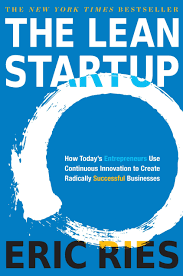Eric Ries is the creator of the Lean Startup methodology, a framework designed to help entrepreneurs and organizations innovate more effectively under conditions of extreme uncertainty. His methodology, detailed in his 2011 book The Lean Startup: How Today's Entrepreneurs Use Continuous Innovation to Create Radically Successful Businesses, has become a cornerstone for modern entrepreneurship.
White Paper: E-commerce and Web Applications - Trends, Use Cases, and Best Practices
Eric Ries is the creator of the Lean Startup methodology, a framework designed to help entrepreneurs and organizations innovate more effectively under conditions of extreme uncertainty. His methodology, detailed in his 2011 book The Lean Startup: How Today's Entrepreneurs Use Continuous Innovation to Create Radically Successful Businesses, has become a cornerstone for modern entrepreneurship.
Key Concepts of the Lean Startup
- Validated Learning: The Lean Startup emphasizes learning what customers truly want through rapid experimentation and data-driven decision-making, rather than relying on assumptions or intuition[2][3].
- Minimum Viable Product (MVP): Entrepreneurs are encouraged to develop an early version of their product with just enough features to gather customer feedback, allowing for iterative improvements[3][4].
- Build-Measure-Learn Feedback Loop: This iterative process involves building a product, measuring its performance, and learning from the results to refine or pivot the approach[2][3].
- Pivot or Persevere: Based on validated learning, startups decide whether to continue on their current path or pivot to a new strategy[3][4].
- Innovation Accounting: The methodology introduces actionable metrics to measure progress and avoid vanity metrics that do not reflect actual growth or learning[2].
Origins and Applications
Ries developed the Lean Startup principles from his experiences as a startup founder and advisor. He drew inspiration from lean manufacturing principles (e.g., Toyota Production System) and agile development practices, adapting them for entrepreneurial settings[3][5]. Notably, he applied these ideas during his tenure at IMVU, where he pioneered rapid experimentation and customer-centric development[5].
The Lean Startup has been adopted by companies of all sizes, including General Electric and Dropbox, demonstrating its versatility in both startups and established corporations[3][6].
Impact
The Lean Startup has transformed how businesses approach innovation by prioritizing agility, customer feedback, and efficient use of resources. It has also influenced broader business practices by encouraging iterative design and continuous improvement over traditional long-term planning[4][6].
Trends in E-commerce
- Omnichannel Experience: Businesses are integrating online and offline experiences to provide a seamless customer journey.
- AI and Personalization: AI algorithms analyze user behavior to deliver personalized product recommendations.
- Voice Commerce: Voice assistants like Alexa and Google Assistant facilitate hands-free shopping.
- Mobile-First Design: With mobile devices driving most e-commerce traffic, responsive design is essential.
- Subscription Models: Subscription services are gaining traction for convenience and predictability.
Web Design for E-commerce Applications
Effective web design is a crucial component of successful e-commerce applications. A well-designed interface can drive higher conversions, improve user engagement, and build customer trust. Key principles include:
- User Experience (UX): Ensure intuitive navigation, clear product categorization, and simple checkout processes.
- Responsive Design: Implement mobile-friendly layouts that adjust seamlessly across devices.
- Visual Hierarchy: Use prominent call-to-action (CTA) buttons and maintain a clean, uncluttered layout.
- Accessibility: Ensure inclusive design with alt text, proper contrast, and screen reader compatibility.
- Performance Optimization: Minimize load times using image compression, lazy loading, and content delivery networks (CDNs).
- Trust and Security: Display trust signals like SSL certificates, customer reviews, and secure payment options.
Key Components of E-commerce Web Applications
- Product Management: Manage product catalogs with descriptions, pricing, and inventory.
- Payment Gateway Integration: Securely handle payments through providers like Stripe or PayPal.
- User Management: Provide authentication, profiles, and personalized recommendations.
- Order Management: Track orders, shipments, and returns.
- Analytics and Reporting: Monitor user behavior, sales performance, and operational efficiency.
Use Cases
1. Retail and Marketplace Platforms
- Example: Amazon, eBay
- Solution: AI-powered recommendations, secure payment gateways, and logistics management.
2. Direct-to-Consumer (DTC) Brands
- Example: Warby Parker, Glossier
- Solution: Mobile-optimized sites, AR/VR product previews, and personalized marketing.
3. Subscription and Membership Platforms
- Example: Netflix, Birchbox
- Solution: Automated billing, recommendation engines, and content personalization.
4. B2B E-commerce
- Example: Alibaba, Shopify Plus
- Solution: Bulk pricing, custom order management, and multi-user accounts.
5. On-Demand Services
- Example: UberEats, Instacart
- Solution: Real-time tracking, dynamic pricing, and predictive analytics.
Best Practices
- User-Centric Design: Prioritize intuitive navigation and seamless user experiences.
- Scalability: Implement cloud-based solutions for elasticity during peak periods.
- Security: Ensure robust cybersecurity measures, including data encryption and secure authentication.
- Performance Optimization: Use content delivery networks (CDNs) and caching strategies.
- Data-Driven Decision Making: Leverage AI-powered analytics to optimize product offerings and marketing campaigns.
Conclusion
E-commerce web applications are driving business growth by offering personalized, efficient, and secure shopping experiences. By leveraging emerging technologies, adopting effective web design principles, and following best practices, businesses can remain competitive in the rapidly evolving digital marketplace.
References
- Eric Ries, The Lean Startup: How Today's Entrepreneurs Use Continuous Innovation to Create Radically Successful Businesses, 2011.
- Harvard Business Review, Why the Lean Start-Up Changes Everything, 2013.
- Shopify, E-commerce Trends Report, 2024.
- McKinsey & Company, State of E-commerce, 2023.
- Gartner, Market Guide for E-commerce Platforms, 2024.
- https://www.goodreads.com/book/show/10127019-the-lean-startup
- https://en.wikipedia.org/wiki/The_Lean_Startup
- https://hbr.org/2013/05/why-the-lean-start-up-changes-everything
- https://theleanstartup.com
